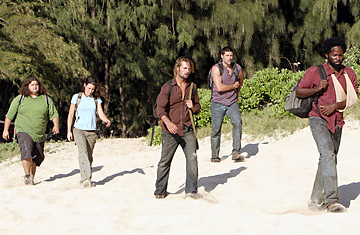
A scene from ABC's Lost
Most people regard watching television as a passive activity. You sit, you watch. Occasionally, you change the channel. But a new study reveals that even this passive diversion may lead to actively damaging effects, particularly when it comes to issues of race.
In a series of intricately designed experiments, psychologists at Tufts University demonstrate that subtle racial biases are often expressed by characters on popular television shows, and that viewers not only pick up these attitudes but allow them to shape their own outlooks on race. The most insidious part of this cultural traffic, the researchers found, is that the transmission of race bias appears to occur subconsciously, unbeknownst to the viewer.
Led by Max Weisbuch, a postdoctoral student in the lab of Tufts psychology professor Nalini Ambady, researchers designed the multipart study to examine the communication of race bias on television to white college-age volunteers. Weisbuch and his team were intrigued by the fact that despite a significant reduction in overt expressions of racism in modern American society — the country has, after all, just elected its first black president — studies consistently find that many people still show biased or negative attitudes toward African-Americans, primarily through nonverbal means such as facial expressions, crossed arms and averted gazes. The psychologists wondered how such biases could persist in a society in which racism is socially unacceptable and indeed publicly denounced.
So the group decided to examine the medium of television, which connects the vast majority of Americans, and through which many people predominantly receive their social and cultural cues. The study looked at 11 popular prime-time TV shows, such as Heroes, Scrubs, House, CSI: Miami and Grey's Anatomy, whose casts include both white and black recurring characters of equal status.
In the first of a series of four studies, researchers showed participants TV clips in which a white character and black character interact — but the segments were stripped of sound and the black character was digitally deleted. The idea was to ensure that neither race nor dialogue would color viewers' analysis. The exercise was repeated with the white character deleted. Researchers then asked the viewers, white college students, to evaluate in each circumstance, whether the unseen character appeared to be treated positively or negatively by the seen character, and how well liked he or she appeared to be. In the end, across the majority of TV shows, viewers consistently said that the white characters had received more positive treatment and were better liked than their black counterparts.
What fascinated Weisbuch was that the viewers' judgment of the characters was based purely on nonverbal cues, from facial expressions to body language. In fact, when participants were given transcripts of the verbal content of the clips, they saw no difference in the way black or white target characters were treated by speaking characters. These expressions may have been scripted into the show by writers, or by productions editors or the director, but nevertheless, researchers say they demonstrate unfavorably biased attitudes toward black characters.
Next, researchers tried to figure out whether this nonverbal bias was being communicated to people watching the show. Researchers created two sets of short, silent clips, one pro-white and the other pro-black. In the pro-white set, white characters were treated positively and black characters were treated negatively; in the pro-black clips, the reverse was true. A separate group of students was asked to view either the pro-white or pro-black TV clips. Afterward, the students completed a questionnaire that was presented as a different study, but actually served as a measure of their racial bias. The results suggested that students who viewed the pro-white clips were much more likely to demonstrate racial bias than those watching the pro-black clips. "That suggests that exposure to the nonverbal behaviors affects bias," says Prof. Ambady.
The scientists went on to demonstrate that the viewers were unaware of the clips' effect. In another part of the study, students were asked to watch the same pro-white and pro-black clips, but this time they were also instructed to be on the look- out for evidence of subtle biased behavior. Afterward, viewers were asked to determine whether white characters or black characters were treated better.
Because each set of clips was created to favor one group or the other, there was only one right answer to the question. The students had a 50-50 chance of responding correctly — and that's exactly how well they did, no better than chance. In other words, the patterns of bias expressed in the characters' nonverbal behavior were not obvious to the viewers. "The effect [television has] on viewers might be something less than conscious," says Weisbuch.
The findings suggest that despite the progress that has been made in addressing racism in the America, we may still be perpetuating prejudice in subtle ways — and, if Weisbuch's findings are validated, in ways that we may not even realize. "Human beings are thinking, cognizant, conscious beings who can be strategic and intentional," says John Dovidio, a professor of psychology at Yale University who wrote an editorial accompanying Weisbuch's study, published Thursday in Science. "But we are also kind of emotional and we do a lot of things without full conscious awareness. What this research suggests is that although our minds are in the right places, and we may truly believe we are not prejudiced, our hearts aren't quite there yet."
Acknowledging the disconnect may be the first step in bridging the gap between our hearts and minds, says Ambady. Figuring out exactly where and how subtle biases creep into our culture would be a start. To do that, we may have to start watching television more actively, and astutely, instead of passively absorbing everything we see.
